Exploring the Depths of Skate Junt Culture
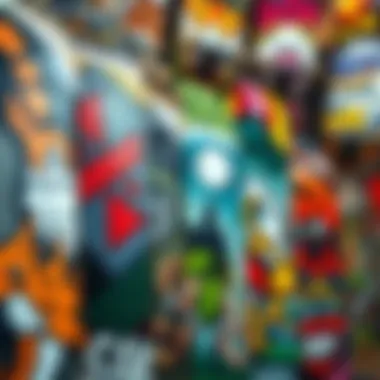
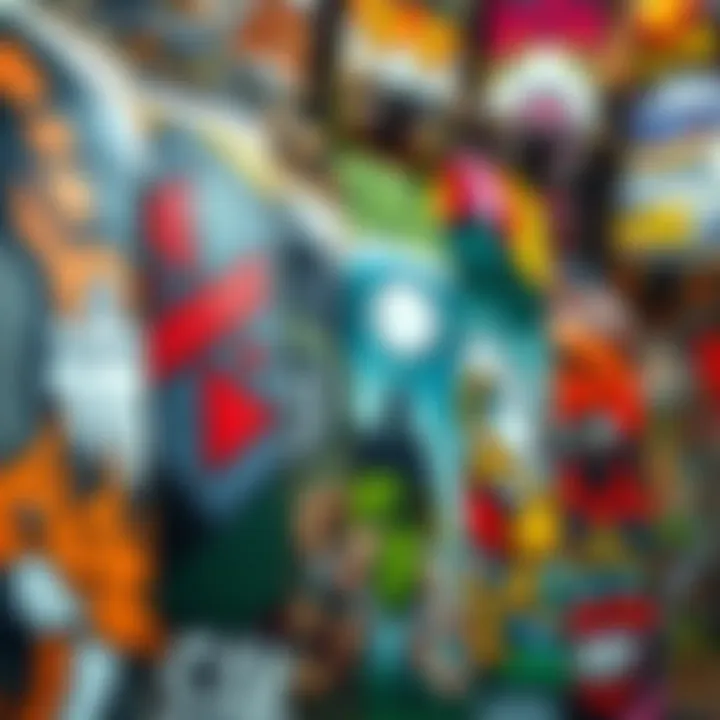
Intro
Skateboarding is more than just a sport; it's a vibrant culture steeped in history and community. The term skate junt encapsulates a variety of elements, from the aesthetic choices made by skaters to the unwritten codes that guide their interactions. In this exploration, we will peel back the layers of this culture, ultimately revealing how it shapes not only the identity of skateboarders themselves, but also the broader youth culture.
This examination aims to unfold the social dynamics that coexist within skateboarding, highlighting how a simple act of riding a board can create a rich tapestry of artistic expression and collective identity. Throughout the article, we will unpack the myriad ways skate junt influences the world of skateboarding and beyond, shedding light on its implications for the next generation.
Skateboarding Techniques
To truly appreciate skate junt, one has to understand the fundamental techniques of skateboarding. It's in mastering these skills that skaters begin to express their individuality and creativity. Let’s break down the essential tricks and moves.
Essential Tricks for Beginners
For those just stepping on the board, it’s essential to start with the basics. Here are some key tricks that every novice should get the hang of:
- Ollie: The cornerstone of many tricks, the ollie is all about lifting the board into the air without using your hands.
- Kickflip: After mastering the ollie, the kickflip adds a spin to the board, making it rotate horizontally beneath you as you jump.
- Heelflip: Similar to the kickflip, but instead of using the toes to flick, you use the heel which changes the board's rotation direction.
- Manual: This is like a wheelie on a bike and showcases balance and control.
- Bert Slide: It involves sliding sideways as you go over a ledge, aligning the board to the edge for style points.
Starting with these tricks builds a strong foundation and gives skaters the confidence to explore further.
Advanced Maneuvers for Experienced Skaters
Once the basics are nailed down, the world opens up for more intricate tricks that push the boundaries of creativity:
- 360 Flip: Combining the ollie, kickflip, and a 360-degree spin, this trick demands precision.
- Nollie: This trick requires popping the front of the board while your back foot pushes down, flipping the board forward while jumping.
- Grinds and Slides: Utilizing edges of skate parks or rails, grinds and slides challenge balance and technique.
Experiencing and experimenting with these advanced moves will enhance not only a skater's skills but their place within the skate junt community.
Gear and Equipment Reviews
Having the right gear can make a significant difference in a skater's experience and safety. Choosing equipment that matches one's skill level and style is crucial.
Top Skateboards for Every Skill Level
When it comes to selecting a skateboard, skaters are often faced with overwhelming options. Here are notable recommendations:
- Beginner Skateboard: Element Skateboards offers a balance of quality and affordability, making it a great entry-level choice.
- Intermediate Skateboard: For those ready to advance, Santa Cruz Skateboards provides durability combined with top-notch design.
- Advanced Skateboard: Birdhouse Skateboards aims to cater to advanced skaters focusing on performance and style.
Protective Gear: Importance and Recommendations
Safety should never take a back seat. It’s vitally important to wear protective gear, whether learning basic techniques or mastering skateboarding maneuvers. Here’s what should be on every skater's checklist:
- Helmet: A reliable helmet is non-negotiable. Brands like Triple Eight lead the pack.
- Wrist Guards: They protect against falls, especially for beginners practicing tricky foot placements. Pro-Tec is a good go-to.
- Knee and Elbow Pads: These are crucial for serious skaters who take heavy spills. Consider options from 187 Killer Pads.
"A good skater knows their gear just as well as they know their tricks. It’s all connected."
Navigating the world of skate junt goes beyond just riding a board. It’s about fostering a sense of identity, community, and artistic expression. From mastering techniques to choosing the right gear, every aspect plays a part in shaping the experience of each skater. As we delve deeper into this culture, we will uncover how it influences not just the sport but the youth and society at large.
For more information on skateboarding culture, you can visit Wikipedia on Skateboarding or explore forums discussing experiences and insights at reddit.
Stay tuned as we continue this exploration!
Understanding Skate Junt
In the vibrant world of skateboarding, the term "skate junt" plays a pivotal role. It extends beyond mere skate tricks and stunts; it's about the community, the culture, and ultimately, a shared identity among skateboarders. Understanding skate junt is crucial in grasping how these elements interact and influence each other. By sharing a common language, values, and experiences, skateboarders forge a unique bond that transcends age, background, and skill level.
Definition of Skate Junt
Simply put, skate junt can be seen as the collective culture and community surrounding skateboarding. It’s not just about the act of skating but encompasses a lifestyle, a way of thinking, and connecting with others who share a passion for the sport. This term reflects the unfiltered, raw essence of skate culture, where authenticity and creativity intersect.
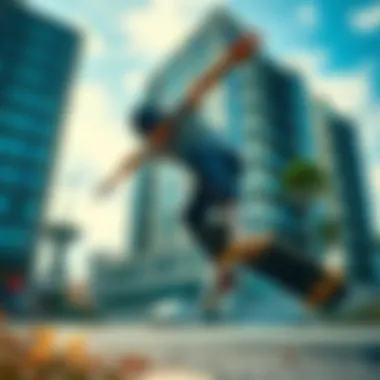

To delve deeper, some may define it as the informal gathering of individuals who skate together, exchanging not just tricks but also stories, influences, and inspirations. But this definition only scratches the surface. Skate junt embodies the spirit of rebellion, freedom, and individuality that skateboarding represents.
Historical Context
The roots of skate junt can be traced back to the early days of skateboarding in the 1960s and 1970s. Evolving from surfing, skateboarding began as an alternative for those landlocked and craving similar thrills. The first skate parks emerged in California, providing a dedicated space that fostered community but also introduced competition among skaters.
As the years rolled on, skateboarding transitioned from underground subculture to a global phenomenon. The 1980s and 90s saw the rise of skate brands like Dogtown and Powell Peralta, which shaped a new identity for the sport. Video parts, magazines, and early skate films created a shared narrative that solidified the culture.
During this period, language and style of skate junt emerged, influenced by the music of the time—punk rock, hip-hop, and alternative scenes blended effortlessly. Amidst this backdrop, the skate community became a sanctuary for misfits and non-conformists, further reinforcing the unity found within skate junt.
Cultural Relevance
Skate junt is not merely a term for those who ride boards; it carries profound cultural significance. It serves as a lens through which one can examine social interactions within the skateboarding world. The cultural relevance of skate junt can be seen in multiple ways:
- Social Identity: It allows individuals to express a multi-faceted identity while promoting solidarity within groups.
- Artistic Expression: The creativity involved in skateboarding flows into various forms of art, particularly street art and graffiti, which are often embedded in skate parks and urban landscapes.
- Inclusion: While many might associate skating with exclusion, skate junt emphasizes inclusivity, attracting a diverse crowd of skaters who connect beyond traditional boundaries.
"Skateboarding is not just about the ride; it's about how we come together to ride it."
Understanding skate junt opens doors to appreciating the diversity and vibrancy within the skateboarding community. By delving into its definition, historical context, and cultural relevance, one gains a comprehensive view of how deeply intertwined skateboarding is with society and its evolving narrative.
The Social Fabric of Skateboarding
Skateboarding isn’t just about nailing that perfect ollie or grinding the edge of a rail; it's a rich tapestry woven from diverse threads. The social fabric of skateboarding has significant influence on how individuals connect, relate, and identify within the skate junt culture. Understanding this social framework helps uncover the deeper meaning behind the sport and its community.
Community Dynamics
At first glance, the skateboarding community can seem like a chaotic mix of personalities, styles, and backgrounds. However, dive a little deeper, and you’ll see that it thrives on a unique synergy that fuels its very essence. Community dynamics are not simply about a group of skateboarders hanging out; it’s about forming interconnected networks where everyone plays a crucial role.
- Shared Experiences: Whether it's the thrill of learning a new trick or the sting of falling hard, skateboarding creates shared experiences that forge bonds among riders. These moments cultivate a sense of belonging that often transcends age or skill level.
- Roles and Hierarchies: You might see someone taking on the role of a mentor for newcomers while veterans often lead sessions with words of wisdom. Yet, there’s no strict hierarchy; each individual contributes their flavor, making every session dynamic and reflective of the community’s collective identity.
In essence, community dynamics allow skateboarders to be part of something bigger than themselves. It's that feeling of being in the right place, making each person feel valued in their shared passion.
Inclusion and Exclusion
The skatin' world is often viewed through a lens that highlights both inclusion and exclusion. On one hand, skateboarding is celebrated as an inclusive sport that welcomes everyone—regardless of gender, race, or social status. On the other hand, it can also harbor elements of exclusion.
- Inclusivity Efforts: Many local skate shops and organizations actively support diversity initiatives to ensure that all voices are heard. Programs that teach skateboarding to underprivileged youth or women-only skate events are prime examples of efforts that push back against exclusion.
- Barriers to Entry: However, the gritty reality is that some might face barriers in the form of intimidating environments or unwelcoming groups. Factors like economic disparities or local stereotypes can create invisible walls that discourage participation.
Navigating the thin line of inclusion and exclusion forces skaters to continuously reflect on their practices and the atmosphere they cultivate within their parks and streets.
Artistic Expression within Skate Junt
Artistic expression serves as a vital pulse within skate junt culture, intertwining various forms of creativity with the lifestyle and identity of skateboarders. It transcends mere visual appeal or sounds; it reflects the struggles, triumphs, and unique narratives that characterize the skateboarding community. When one grazes the surface of skate junt, it's like peeling back layers of a complex onion where every slice reveals insights about individuality, community, and artistry.
From graffiti adorning urban landscapes to the inventive fashion statements borne from skateboard culture, artistic expression is deeply embedded in the act of skateboarding itself. Not only does it embellish the environment, but it also fosters a sense of belonging among skaters. This section explores three main pillars of artistic expression: graffiti and street art, influence on fashion, and the role of music in sculpting the soundscape of skateboard culture.
Graffiti and Street Art
Graffiti has long been a voice for the marginalized and an essential element of urban landscapes. Within skate junt, the clash of creativity and rebellion is palpable in every spray of a can. Skaters often turn concrete jungles into canvases, using bits and bobs of pink and yellow paint to breathe life into otherwise dull walls. This fusion of skateboarding and graffiti isn't just about vandalism; it becomes a dialogue—an unfiltered exchange illustrating the emotions of those living in these vibrant yet sometimes harsh environments.
Here are a few ways that graffiti and street art resonate within the skate culture:
- Personal Stories: Artists often embed personal narratives into their graffiti, allowing them to showcase their backgrounds and experiences.
- Public Space Utilization: Skateboarders and street artists transform neglected or mundane areas into vivid spaces of creativity.
- Social Commentary: Much of the graffiti stems from social issues, serving as a visual commentary on the challenges and inequalities faced by the community.
Influence on Fashion
The skateboarding world has always danced hand-in-hand with fashion, and this relationship serves not only as a personal expression for skaters but as a cultural statement. The clothing often reflects a blend of functionality and attitude. Think of wide, relaxed-fit pants you can effortlessly flow in or graphic tees that carry the stories or identities of the skater.
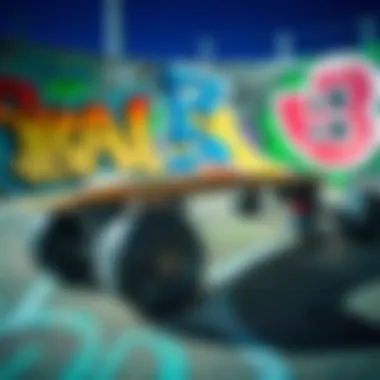
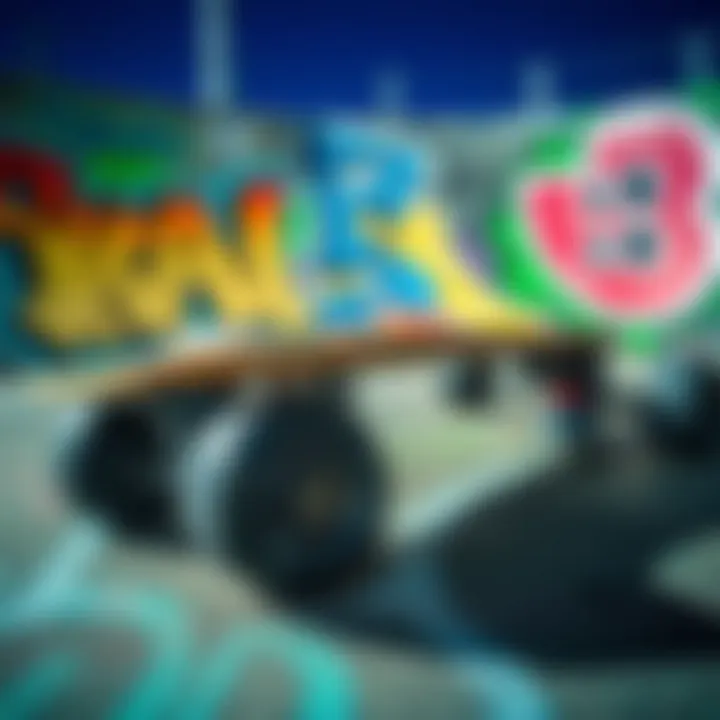
- Unique Aesthetics: Skate brands like Supreme and Thrasher create styles that resonate with the skater ethos. Each article of clothing or accessory tells a little story.
- Subcultural Significance: Skate fashion speaks volumes about belonging. Wearing certain brands can symbolize alliance with a particular skating crew or ideology.
- Influence Beyond Skate: The impact of skate fashion has spilled into mainstream culture, affecting high fashion, streetwear, and casual attire alike.
Music's Role in Shaping Culture
Music flows as seamlessly through skate culture as the wheels of a board on concrete. It’s in the rhythm of a skater’s movements, the adrenaline of new tricks, and the vivid memories made at skate parks. Genres like punk rock, hip-hop, and electronic music have influenced many skaters and often define the ambient landscape of a session.
"Music is the heartbeat of skating, setting the tone for everything we do on the board."
The interplay of music and skateboarding isn't just an aesthetic choice; it is instrumental in shaping attitudes, building camaraderie, and encouraging creative freedom.
- Community and Connection: Jams and skater shows often bring people together, forging connections over shared musical tastes.
- Expression through Lyrics: Many skater anthems address themes of freedom, rebellion, and individualism that resonate deeply within the community.
- Cultural Crossover: Skate videos frequently utilize undeniably cool soundtracks, making them iconic in their own right while further blurring the lines between music and skate culture.
In summary, artistic expression within skate junt is more than just aesthetic; it forms the undercurrent that supports community bonding, individual identity, and cultural dialogue. Through graffiti, fashion, and music, skateboarders carve their pathways, express their stories, and connect with one another in profound, sometimes unexpected ways.
Skate Junt and Identity Formation
Skateboarding is more than just a sport or an activity; it's a lifestyle that molds and shapes the very identities of those who embrace it. In diving into the confluence of skate junt culture and identity formation, it becomes clear that this subculture nurtures individuals not only through their passion for skateboarding but also by providing a community where they can express, share, and evolve their identities. The significance of individual and group identity within this culture can be drawn from various elements, such as personal expression, community belonging, and the ongoing battle against stereotypes.
Personal Identity in Skateboarding
When young skate enthusiasts take to the streets or parks, they are engaging in more than just performing tricks; they are crafting their personal narratives. For many, skateboarding acts as a bridge to discovering who they really are. Each skateboard deck, shoe choice, and trick landed represents a piece of their identity. This process of self-exploration is visceral, as each fall and subsequent rise is a lesson in resilience.
- The act of skating can often be tied to freedom. For many, it stands as an antidote to the constraints of daily life. This feeling of breaking free encourages skaters to experiment with their style, attitude, and social interactions.
- Individual preferences within skateboarding, such as choosing between street skating or ramp tricks, further highlights the varied ways in which skaters forge their personal identities. One may lean toward street life, embodying a gritty urban aesthetic, while another may find solace in ramp parks, exuding a more polished precision.
Group Identity and Belonging
Skateboarding is also about community. For those involved, the skate junt creates a sense of belonging that transcends individual differences. Skating together fosters connections that often feel more genuine than those found elsewhere.
- At skate parks, friendships are built upon the shared love for the sport, and this connection creates an almost familial bond among skaters. The camaraderie in challenging each other to try new tricks or simply hanging out reveals the powerful role community plays in solidifying one's identity within the skate culture.
- Participating in organized events or local contests can deepen this sense of belonging, offering an avenue where skaters unite under a common purpose—the love of skating, the celebration of skills, and the acknowledgment of one another's journeys.
Navigating Stereotypes
Despite the many positive elements woven into skateboarding culture, skaters often find themselves confronting stereotypes and misconceptions. The rugged image of skateboarding can sometimes overshadow its more profound aspects, particularly the values of creativity and respect that thrive within the community.
Skaters navigate a world that often views their passion as rebellious or reckless, forcing them to constantly redefine their image and challenge preconceptions.
- Stereotypes can marginalize particular groups within skate culture, particularly those from diverse backgrounds. Dismantling these stereotypes requires a conscious effort. Initiatives aimed at inclusivity can help create an environment where every skater, regardless of their background, can thrive and contribute to the community.
- Additionally, skaters often harness their experiences with discrimination as fuel for their artistic expression, turning negative perceptions into powerful statements that resonate within the culture.
The Impact of Skate Junt on Youth Culture
The influence of skate junt on youth culture is a multifaceted topic, revealing the deeper layers of socialization, creativity, and personal development within this subculture. At its core, skate junt is more than just a lifestyle or sport; it's a way for young people to find their footing in a world that can sometimes feel daunting and unwelcoming. This section will delve into how skate junt molds behavior, provides creative channels, and fosters mentorship, ultimately shaping the identities of young individuals.
Influences on Behavior
Skate junt profoundly affects behavior among youth. Skateboarding demands not just physical skill, but also mental resilience. When young skaters face the challenges of learning a trick or navigating a new skate spot, they develop a mindset of perseverance. The need to get back up after a fall, both figuratively and literally, teaches important life lessons. It’s often said that every skater has experienced a "wiped out" moment, and that resilience defines their journey.
The camaraderie found within skate parks also plays a crucial role. Relationships forged over shared experiences can lead to improved social skills and emotional intelligence. Skaters are often seen encouraging each other to push beyond their limits, overcoming fear together. This environment diminishes negative behaviors, as skaters support positive affiliations rather than engaging in activities that could lead them astray. In essence, skate junt cultivates a culture of respect, empathy, and support that steers youth toward positive societal contributions.
Creative Outlets for Youth
Creativity is another essential component of the skate junt phenomenon. Skateboarding isn’t solely about the act of riding. It's about self-expression. Skaters often personalize their boards with artwork or stickers that showcase their unique identities. This form of decorating operates as a canvas, demonstrating their likes, influences, and personal stories.
Moreover, many skateboarders extend their artistic inclinations to street art and graffiti, blending movement with visual aesthetics. These elements intertwine, allowing skaters to express opinions or share experiences through their art. Such creative outlets encourage young people to explore their artistic sides and can lead to potential careers in design or visual arts.
Out in the streets, skaters have taken their passion even further. The creation of skate videos, with intricate editing and soundtracks, serves another platform for creativity. These videos often go viral, allowing youth to explore their skillsets in a digital medium. This layering of art and sport challenges the boundaries of conventional art forms and gives a voice to those who might otherwise feel unheard.
Mentorship and Growth


As much as skate junt serves as a vehicle for individual expression, it also opens avenues for mentorship. More experienced skateboarders often take on a teaching role, guiding novices through the ins and outs of both skating and navigating the broader challenges of adolescence. This mentoring can take place spontaneously in parks or through organized programs.
Mentorship in the skate community instills a sense of responsibility among skaters. It encourages older adolescents to be role models, emphasizing the importance of community and giving back. Those younger look toward their elders not just for tricks but for life advice, fostering an intergenerational connection that benefits both parties. This bond strengthens the culture as a whole.
"In skateboarding, it's not just about tricks—it's about the journey and the people you share it with," notes a skateboard mentor from New York City, emphasizing the critical role of guidance.
Thus, the mentorship aspect of skate junt can be transformative, facilitating growth in confidence, competence, and character. The cyclical exchange of knowledge ensures that the rich culture of skateboarding persists through generations.
Challenges Within the Skate Junt Community
The skate junt community, while vibrant and diverse, faces its own set of challenges that can impact both its members and the broader perception of skateboarding as a whole. Acknowledging and understanding these issues is crucial for fostering a healthier, more inclusive environment for skateboarders. These challenges include conflict and resolution dynamics, financial barriers, and the various perceptions surrounding skateboarding. Each aspect not only shapes the experiences of those involved but also influences how skate culture is viewed by outsiders.
Conflict and Resolution
Conflicts within the skate junt community can arise from multiple sources, such as differing opinions, competition for resources, or even clashes of style. Skateboarding is, after all, an art form that lends itself to personal expression and individualism. When members of the community hold strong convictions about tricks, stances, or even the best spots to skate, disagreements can quickly spiral into more serious disputes.
When such conflicts occur, it’s crucial to ensure that resolution is achieved not through aggression but through dialogue. Open conversations allow individuals to express their concerns and find common ground, often leading to innovative solutions that respect differing perspectives. Community events, workshops, or even informal gatherings provide platforms where skateboarders can come together, share experiences, and solve issues collaboratively.
"Every skate session is imbued with the possibility of learning, not just tricks but also the art of compromise."
Financial Barriers
Skateboarding, unfortunately, isn't always an easy sport to enter due to financial hurdles. From the cost of equipment, like skateboards and protective gear, to access to suitable locations for practice, these financial barriers can deter many aspiring skateboarders. Many communities lack affordable skateparks, which can lead to frustration and discourage participation.
To mitigate this issue, community-driven solutions can be instrumental. Fundraising events, sponsorships from local businesses, and partnerships with non-profit organizations dedicated to promoting skate culture can all help alleviate some of the financial strain. Not only does this create a more equitable playing field, but it also helps to cultivate a sense of shared ownership within the community. Skateboarders tackling financial barriers together, whether through collective contribution or resource sharing, fosters unity and inclusivity.
Perceptions of Skateboarding
The way skateboarding is perceived by outsiders can significantly impact the skate junt culture. Often, skateboarding is viewed as a rebellious activity or a nuisance, particularly in urban settings. These perceptions can lead to negative stereotypes, which in turn affect the community's self-image and acceptance within broader societal frameworks.
Skaters are not merely troublemakers; they embody creativity, resilience, and camaraderie. This narrative needs to change through consistent outreach and positive community engagement. Demonstrating how skateboarding contributes to local culture—through art, music, and community bonding—can help reshape perceptions. Initiatives such as skate demonstrations, local collaboration with schools, and public showcases can introduce the beauty of skate culture to a wider audience, fostering understanding and respect.
Addressing these challenges enables the skate junt community to evolve. Fostering an environment where conflicts can be resolved amicably, overcoming financial obstacles collaboratively, and changing external perceptions can help solidify the community's foundation. Only then can skateboarding transition from mere activity to a profound cultural phenomenon.
Future of Skate Junt
The future of skate junt is both exhilarating and uncertain, capturing the imagination of skateboarders and enthusiasts alike. As the sport continues to evolve, understanding where it's heading becomes paramount. Skate junt is not merely a trend—it's a culture that adapts and transforms, reflecting the lives of those who skate. By dissecting its future, we can uncover vital insights that affect communities, elevate artistic expressions, and foster new opportunities.
Evolving Trends
With each passing year, fresh trends sweep through the skateboarding world like a gust of wind. Technological advancements, such as high-performance skateboards and apps that connect skaters, are altering how skateboarders interact with one another and the urban landscapes they navigate.
In recent times, there has been a noteworthy shift towards video creation and sharing. Skateboarders are harnessing platforms like Instagram and TikTok to showcase their skills and creativity. This has democratized skateboarding, allowing anyone with a board and a smartphone to contribute to the culture. Moreover, the rise of virtual reality skateboarding experiences offers a unique insight into the sport, complementing the physical action.
As we observe these trends, it’s crucial to acknowledge that they don't exist in a vacuum. Skateboarding gear designers are incorporating sustainability into their practices, embracing eco-friendly materials. This aligns with a broader cultural shift towards environmental consciousness among younger generations
Potential for Growth
The potential for growth in skate junt culture is immense. Skate parks are sprouting up in urban areas, driven by city initiatives to promote inclusive recreational spaces. This not only provides a haven for seasoned skaters but also introduces newcomers to the sport. The diverse backgrounds of these newcomers add richness to the community, fostering a blend of skills and creativity.
Moreover, the inclusion of skateboarding in the Olympics marks a pivotal moment. This recognition elevates the sport, drawing attention from media and sponsors. With more funding, pros now have avenues to pursue their talent full-time, nurturing up-and-coming skaters through mentorship programs. This could reshape how skateboarding is perceived, positioning it not just as a pastime but as a legitimate path for career-focused youth.
Key Factors for Growth:
- Increased Visibility: Media representation boosts interest, inspiring youth to try skating.
- Support from Local Authorities: Initiatives to build skate parks demonstrate commitment to community and personal development.
- Diverse Representation: The emergence of skaters from various backgrounds enriches the culture and highlights shared passions.
Preservation of Culture
As skateboarding propels toward the future, the preservation of the existing culture becomes crucial. Skate junt is entrenched in history, with roots tracing back to the 1970s. Maintaining its rich traditions while evolving requires a delicate balance. Respecting the past while embracing change is essential to keep the identity of skateboarding alive.
The challenge lies in commercializing the sport without diluting its essence. It's vital for the community to remain vigilant against exploitative practices that might undermine authentic expressions of skateboarding. A grassroots approach, where decisions come from within the riding community, often leads to genuine representations of the culture.
“Preservation is not about clinging to the past but safeguarding the essence for the future.”







